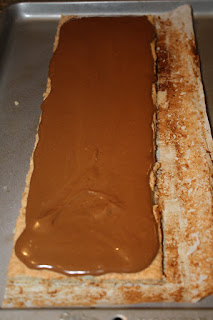Ja sam jedan od onih rijetkih koji nije znao za Reform Tortu. Najvjerovatnije ne zato sto je nisam prije vidio ili jeo, nego zato sto me donedavno nije zanimalo kako se koji kolac/torta zove.
Prvi put mi je ime ostalo kada su Brcici donijeli kutiju kolaca na Blue Mountain, i kada je Zlatko nagovarao Ranku da proba Reform Tortu...Kako god, onda je Dade na Majinom blogu detaljno napisao sve sto se treba znati o torti, a ja sam jos citao o Reform Torti na Maxivida-nom blogu, gdje je potpuno zasluzeno na Hall of fame. Da ne bih slucajno uradio nesto kako ne treba, konsultovao sam i Veliki Narodni Kuvar, i dosao da zakljucka da sam spreman uhvatiti se u kostac sa pravljenjem reform torte.
Napraviti i ispeci kore, umutiti i skuvati na pari fil, ohladiti sve, filovati na kraju, jednostavno zar ne?
E evo kako je to kod mene ispalo...
Potrebno:
Za kore:
12 bjelanaca
400 g samljevenog badema
300 g secera
Za fil
12 zumanaca
200 g secera
100 g cokolade za kuvanje
200 g putera
Za glazuru
100 g cokolade
100 ml mlijeka
20 g secera
1 jaje
50 g badema, isjeckanih na listice
A napraviti ovako:
1. Umutiti zumanca sa secerom dok ne 'pobijele'.
2. Ugrijati rernu na 200° C. Podmazati 2 pleha velicine 25cmx35cm, pa staviti papir za pecenje preko.
4. Dodati 200 g badema, promijesati kasikom, sipati u pleh, poravnati
i peci 15 do 20 minuta.Uraditi tako dva puta, i ohladiti kore.
5. Korama odrezati ivice. Ko god da je sa vama i pravi vam drustvo dok pravite tortu, dajte mu odreske :).
6. Izrezati kore po duzini da se dobiju 4 kore. Ostaviti papir na njima, pa poceti sa filovanjem.
7. Staviti drugu koru preko fila, pa pazljivo oguliti papir. Tako uraditi i sa ostalim korama.8. E sada, kada vam kore kazu da fil nije bio dovoljno hladan i cvrst, i da su odlucile da se 'prosetaju',
9. Oblozite plasticnom folijom posudu oblika polulopte.
10. Izrezite tortu na trake, kocke, pa sve ubacite u posudu, poravnajte kasikom, pa pokrijte sa folijom i stavite u zamrzivac.
11. Za glazuru (kao sto Dade rece), otopite šećer u mlijeku i dodajte puter. Kada se i on otopi, u ključalu smesu sipajte jaje koje ste malo umutili mikserom, i sklonite odmah sa vatre. Još malo mutite mikserom, a onda ubacite i 100 g čokolade. Kad se čokolada otopi, mikserom sve sjedinite.
12. Ohladjenu 'tortu' prevrnuti na resetku ispod koje ste stavili pak papir. Preliti 'tortu' vrucom glazurom.
Staviti 'tortu' sa resetkom opet u zamrzivac na hladjenje 15 minuta. Preliv sa papira vratiti u serpu.
13. Izvaditi 'trtu' iz zamrzivaca pa opet preliti sa glazurom.
Pa jos jednom u zamrzivac, a ostatak preliva podijeliti sa nekim ko jos ima strpljenja da bude sa vama.
14. Ohladjenu tortu posuti-ukrasiti listicima badema, i sluziti...
Tako je moj prvi pokusaj da napravim Reform Tortu zavrsio neuspjehom, i najveci razlog sto nisam 'tako pazljivo' procitao Dadin recept. Kaze lijepo covjek ostavi fil nekoliko sati da se ohladi, a kod mene je to trajalo vise kao nekoliko minuta...Kazu pametni se uce na tudjim greskama, a oni drugi (kao ja) na svojim :).
Kako god, ukus torte je stvarno fenomenalan, probacu je opet praviti to znam...


































